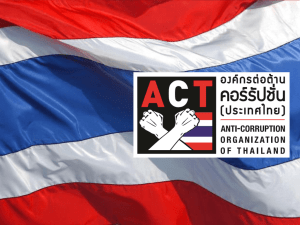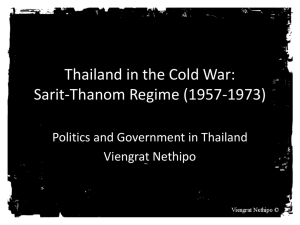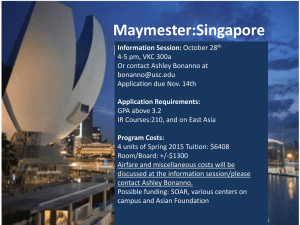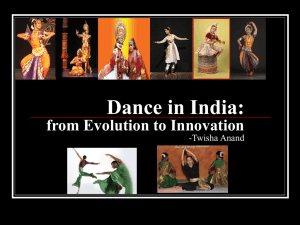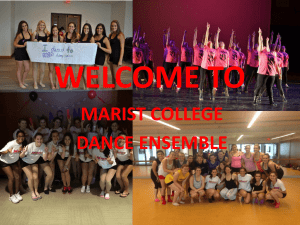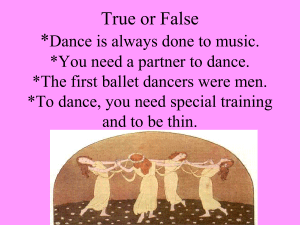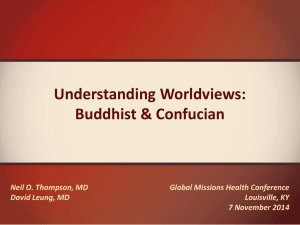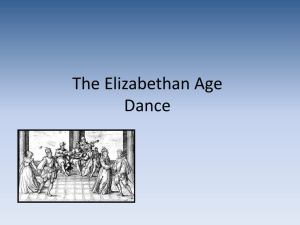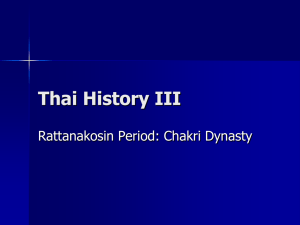THAILAND CULTURE
advertisement
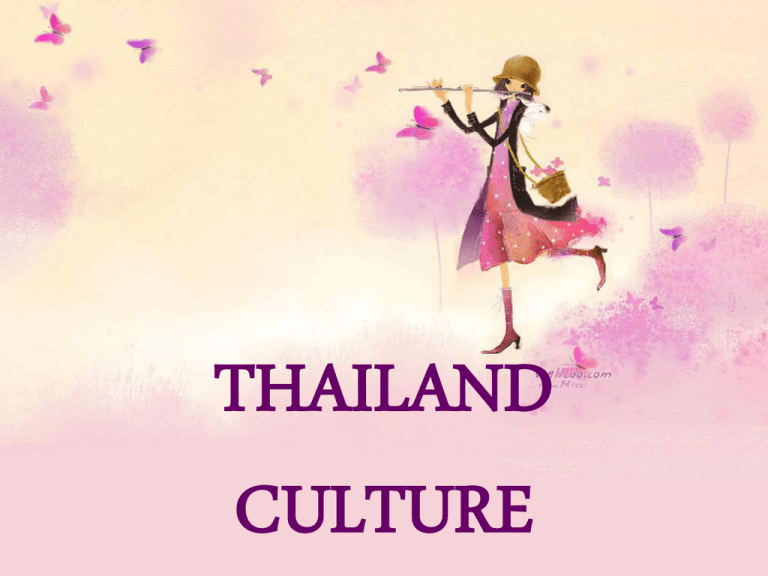
THAILAND CULTURE The Thai greeting The Thai greeting referred to as the wai consists of a slight bow, with the palms pressed together in a prayer-like fashion. It is very similar to the Indian Anjili Mudra/namaste and the Cambodian sampeah. The higher the hands are held in relation to the face and the lower the bow, the more respect or reverence the giver of the wai is showing. The wai is also common as a way to thank someone or apologise. The word often spoken with the wai as a greeting or farewell is sawatdee . Phonetically, the word is pronounced "sa-wat-dee". This word was coined in the mid-1930s by Phraya Upakit Silapasan of Chulalongkorn University. Phraya Upakit Silapasan This word, derived from the Sanskrit svasti (meaning "well-being"), had previously been used in Thai only as a formulaic opening to inscriptions. The strongly nationalist government of Plaek Pibulsonggram in the early 1940s promoted the use of the word sawatdee amongst the government bureaucracy as well as the wider populace as part of a wider set of cultural edicts to modernise Thailand. Jompol . Plaek Pibulsonggram Origin The wai originated from an ancient greeting that was done to show neither individual had any Weapons. There exist multiple versions of the greeting based on social class, gender, and age. The gesture may come from Buddhism , which sometimes involves prostration , or clasping the hands together and bowing to the ground. The Thai Language The Thai language is comprised of 44 consonants, 32 vowels and five tones in Thai pronunciation, along with a script that has Indian origins. The Thai language, belonging to the Tai family, is the main language in Thailand although there are several regional dialects as well. Other languages spoken in Thailand are Chinese, Lao, Malay and Mon-Khmer, while English use is becoming more prevalent in government and commerce. English is also being taught as a second language in secondary school and universities, which enables the English speaking visitor in Thailand to have little trouble conversing. Information Provided by the Thai Embassy King Ramkhamhaeng the Great who ruled the Sukhothai Kingdom from 1279-1298 initiated the Thai inscription in 1292. The inscription is considered to be a seminal source of Sukhothai history as well as a masterpiece of Thai literature. Conservative and courteous social behavior and dress are highly valued by the Thais. The Thai pronouns for "I" are different for male and female speakers. Men will use 'phom' and women 'dee-chan' in formal settings. However, it is common to drop these formal pronouns in face-to-face conversations or to use kin terms (e.g., elder/younger sibling ; aunt uncle) or first names instead. Men will also show deference by ending their questions and statements with 'khrap', a "polite particle" to show respect and refinement. Women end their questions and statements with 'kha'. In greeting, the Thais normally "wai" rather than shake hands. To make the "wai," place your hands together, bringing them up just under the nose and bow the head slightly. Because it is a sign of respect as well, the younger person initiates the gesture, but not the reverse. The Thais consider the head to be sacred and the feet profane. Touching someone's head, other than a child's, is taboo. A younger person or someone of lower social status will even lower their head in passing by a senior. In sitting too, especially in the presence of monks or other exalted persons, attention must be paid to head level. Even more caution must be taken with the feet because of their contact with dirt. Similarly, the left hand is "polluted" in ritual meaning. Religion in Thailand According to the last Census (2000th) 94.7% of Thais are. Buddhists of the Theravada tradition. Muslims are the second largest religious Group in Thailand at 4.6%. Thailand's Southernmost Provinces - Pattani, Yala, Narathiwat and Songkhla Part of. Chumphon have dominant Muslim Populations, consisting of both Thailand and Ethnic Malay. The TIP of Southern Thailand is mostly Ethnic. Malays . Christians , mainly. Catholics , represent 0.8% of the population with higher Percentages in the North. A Community of tiny But influential. Sikhs in Thailand and some. Hindus also the country's Live in Cities, and are heavily engaged in retail Commerce. Traditions Tradition is an activity that is the continuous practice. Unique and important to society as Composition body language culture religion artistry law moral belief , etc.. Which lead to various ethnic cultures of the society. Become a national tradition and broadcast by each sequence. If tradition is well preserved as it is already the national culture. If it is not good to change the circumstance. Are influenced tradition come from environment external to society. Adopt an integrated practice into a variety of lifestyles. It is known as traditional ways of life of society, especially religion , which is most influenced Thai culture. Various temples. In Thailand reflects the influence of Buddhism with Thai society. And indicated that the Thai focus on Buddhism with Care for the artistic beauty since antiquity as a religious ritual Songkran The Songkran festival is celebrated in Thailand as the traditional New Year's Day from 13 to 15 April. The date of the festival was originally set by astrological calculation, but it is now fixed. If these days fall on a weekend, the missed days off are taken on the weekdays immediately following. If they fall in the middle of the week, many Thai take off from the previous Friday until the following Monday. Songkran falls in the hottest time of the year in Thailand, at the end of the dry season. Until 1888 the Thai New Year was the beginning of the year in Thailand; thereafter 1 April was used until 1940. 1 January is now the beginning of the year. The traditional Thai New Year has been a national holiday since then. The most obvious celebration of Songkran is the throwing of water. Thais roam the streets with containers of water or water guns (sometimes mixed with mentholated talc), or post themselves at the side of roads with a garden hose and drench each other and passersby. This, however, was not always the main activity of this festival. Songkran was traditionally a time to visit and pay respects to elders, including family members, friends and neighbors. Some people make New Year resolutions - to refrain from bad behavior, or to do good things. Songkran is a time for cleaning and renewal. Besides washing household Buddha images, many Thais also take this opportunity to give their home a thorough cleaning. Loy Krathong On the full moon night of the twelfth lunar month, the tide in the rivers is highest and the moon at its brightest, creating a romantic setting ideal for lovers. The Thai people choose this day to hold the 'Loy Kratong' festival, or the 'festival of light.' Loy Kratong is one of the two most recognized festivals in the country. Loy Kratong is probably the most picturesque and beautiful of all Thai celebrations. 'Loy' literally means 'to float,' while 'kratong' refers to the lotus-shaped receptacle which can float on the water. Originally, the kratong was made of banana leaves or the layers of the trunk of a banana tree or a spider lily plant. A kratong contains food, betel nuts, flowers, joss sticks, candle and coins. The making of a kratong is much more creative these days as many more materials are available. The Loy Kratong ritual is a simple one. One needs only to light the candles and the joss sticks, make one's wishes and let it float away with the current of a river or a canal. Different legends surround the origins of Loy Kratong. The most popular version is it was an expression of gratitude to the goddess of water 'Phra Mae Kongka' for having extensively used, and sometimes polluted, the water from the rivers and canals. It is also in part a thanksgiving for her bounty in providing water for the livelihood of the people. November full moon shines, Loi Krathong, Loi Krathong, and the water's high in the river and local klong, Loykrathong's lyrics Loi Loi Krathong, Loi Loi Krathong, Loi Krathong is here and everybody's full of cheer, We're together at the klong, We're together at the klong, Each one with this krathong, As we push away we pray, We can see a better day. Thai Culture on Stamps Thai folk games have been directly and indirectly meaningful for the life of Thai children in many aspects. in joining the games, besides the benefit of doing exercises which is vital for children's physical development, they can also learn to observe the rules of the games. And in so doing, they learn how to compromise as well as how to be a good winner and loser. The children can be initiative in applying surrounding environments to the games and they are also expected to apply what they learn from the games to their daily lives. Such a practice can become a pattern or guideline for them when growing up as adults. The most popular and well-known Thai folk games are Kite flying, Wheel rolling, Catching the last one in the lines, Snatching a baby from the mother snake, Spider clutching the roof, Pebbles tossing and picking, Hide and seek, Touching a finger on the hands, Tug of war, Chase racing, Hiding a cloth behind one's back, Monkeys scrambling for posts, Trapping the fish, Humming and tagging (Kabaddi), Blindfold pot-hitting, Walking with coconut shells, Rope skipping, Piggyback racing, Top spinning, and Banana rib hobbyhorse riding. Blessing a New Car Although it is not common these days because it's not really Buddhism, you can ask a Brahman priest to come to your house to bless a new car. In fact, the priest should be consulted before you buy your car in order to know the precise day and hour it is deemed auspicious to bring your car to your house for the first time. People who are often sceptical about the powers of a blessing in protecting the car and its occupant often rush out to get a blessing after the car has been involved in an accident. Although this is like locking the stables doors after the horse has bolted, the Brahman priest told us that none of the cars he has blessed has been involved in a further accident. She gave the garlands to the priest and received some advice for her future and what she should do to maintain a safe and fruitful life. Then he lit a candle in order to make some water sacred. The priest is putting some of those offered in the car for saving her from an accident. These garlands were offered to the guardian spirits of the school at the special spirit house and some of them were also for the car. Then walked around the car sprinkling it with the blessed water. Whilst he was doing this, the car owner sat in the front seat The Brahman priest put an offering of a jasmine garland on the review mirror, some colored pieces of cloth and painted lucky symbols on the steering wheel and ceiling of the car Thai Village Cultural Show Ordination Into The Monkhood In Thailand, young men usually spend a period of time in the Buddhist Monkhood. Buat Naag is the traditional procession and ceremony for entry into the Monkhood, and is attended by the man's relatives and close friends who make the event into a colorful, joyful and enjoyable occasion as the young man embarks on a period of study and meditation. Fingernail Dance The Fingernail Dance is a graceful dance which originated in the North of Thailand and is usually performed as a gesture of greeting and welcome. Thai Boxing Thai-style boxing, accompanied by its unique ritual and ceremony, is extremely popular in Thailand. Fighters can use just about everything-elbows, hands, feet, knees. It is an art that demands a high degree of skill and fitness. Dance From The North East A mixture of North Eastern dances which collectively express greetings and good luck. Sword Fighting A traditional and historical form of combat-for both male and female. Bamboo Dance Another North Thailand dance which is usually performed when the moon is full. It demands great skill, practice and timing-one slip can be very painful. Thai Wedding Ceremony Here you will have the unique opportunity of seeing the traditional Thai wedding ceremony performed in an authentic manner. It is a ceremony of pageantry, humility, joy and splendour with all the friends and relatives of the newlyweds participating. Kala Dance The Kala Dance comes from the southern part of Thailand. This dance features the use of coconut shells to emphasize the importance of coconuts as part of Thai daily consumption. Yoey Dance From the Central Plains of Thailand, a dance of flirtation and fun. Elephants at Work Literature in Thailand Literature in Thailand was traditionally heavily influenced by Indian culture. Thailand's national epic is a version of the Ramayana called the Ramakien. A number of versions of the epic were lost in the destruction of Ayutthaya in 1767. Three versions currently exist: one of these was prepared under the supervision (and partly written by) King Rama I. His son, Rama II, rewrote some parts for khon drama. The main differences from the original are an extended role for the monkey god Hanuman and the addition of a happy ending. The most important poet in Thai literature was Sunthorn Phu, who is best known for his romantic adventure story Phra Aphai Mani and nine travel pieces called Nirats. Kings Rama V and Rama VI were also writers, mainly of non-fiction works as part of their programme to combine Western knowledge with traditional Thai culture. 20th century Thai writers have tended to produce light fiction rather than literature, but the Isan region has produced two notably sociocritical writers in Kamsing Srinok and Pira Sudham. Thailand has had a wealth of expatriate writers in the 20th century as well. The Bangkok Writers Group is currently publishing fiction by Indian author G.Y. Gopinath, the fabulist A.D. Thompson, as well as non-fiction by Gary Dale Cearley. Ramakien The Ramakien is Thailand's national epic, derived from the Indian Ramayana epic. A number of versions of the epic were lost in the destruction of Ayutthaya in 1767. Three versions currently exist, one of which was prepared in 1797 under the supervision of (and partly written by) King Rama I. His son, Rama II, rewrote some parts of his father's version for khon drama. The work has had an important influence on Thai literature, art and drama (both the khon and nang dramas being derived from it). While the main story is identical to that of the Ramayana, many other aspects were transposed into a Thai context, such as the clothes, weapons, topography, and elements of nature, which are described as being Thai in style. Although Thailand is considered a Theravada Buddhist society, the Hindu mythology latent in the Ramakien serves to provide Thai legends with a creation myth, as well as representations of various spirits which compliment superstitions derived from Thai animism. A painted representation of the Ramakien is displayed at Bangkok's Wat Phra Kaew, and many of the statues there depict characters from it. Traditional Thai musical instruments are the musical instruments used in the traditional and classical musics of Thailand. They comprise a wide range of wind, string, and percussion instruments played by both the Thai majority as well as the nation's ethnic minorities. In the traditional Thai system of organology, they are classified into four categories, by the action used in playing: 1. Plucking (plucked string instruments) 2. Bowing (bowed string instruments) 3. Striking (percussion instruments and hammered dulcimer) 4. Blowing (wind instruments) String Plucked Jakhe - crocodile-shaped fretted floor zither with three strings Phin - three-stringed lute used in the Isan region of northeastern Thailand Phin phia - chest-resonated stick zither played by the Lanna of northern Thailand Sueng - plucked lute from the Lanna region of northern Thailand Bowed Saw duang - higher two-string fiddle with hardwood body; used in classical music Saw sam sai - three-string spike fiddle with coconut shell body; used in classical music Saw u - lower two-string fiddle with a coconut shell body; used in classical music Salo - three-string spike fiddle used in the Lanna region Struck Khim - hammered dulcimer Percussion Drums Taphon or klawng taphon - sacred barrel drum; played with the hands and used in the piphat ensemble Glong thad - large drum played with sticks; usually played in a pair and used in the piphat ensemble Rammana - frame drum; played with the hand Thon - goblet drum; played with the hand Glong yao - long drum; played with the hands Glong chatri - same Glong thad but smaller than,played with sticks,use in the piphat chatri Gong chimes Khong wong lek - higher gong circle; comprises many small tuned bossed gongs mounted in a rattan frame Khong wong yai - lower gong circle; comprises many small tuned bossed gongs mounted in a rattan frame Khong mon - set of many small tuned bossed gongs arranged in vertical curved frame; usually primarily in funeral music Khong rang - set of eight tuned gongs suspended horizontally in a straight frame; similar to the southern Philippine kulintang; rare Keyboard Ranat - trough-resonated keyboard percussion instrument; generally played with two mallets and used in Thai classical and theater music Ranat ek - higher xylophone, with bars usually made of hardwood Ranat thum - lower xylophone, with bamboo or hardwood bars Ranat ek lek - higher metallophone Ranat thum lek - lower metallophone Ranat kaeo - crystallophone; very rare Pong lang - pentatonic log xylophone used in the Isan region Gongs Khong chai , also called khong hui or khong mui - huge hanging bossed gong used for indicating time Khong mong or mong - medium-sized hanging bossed gong used in Thai ensembles Clappers Krap - clapper Krap phuang - bundle of hardwood and brass slats, tied together at one end Krap sepha - pair of bamboo or hardwood sticks Cymbals Ching - pair of small, thick cymbals joined by a cord; used to mark time Chap - pair of flat cymbals joined by a cord Chap lek - smaller Chap yai - larger Shaken bamboo Angkalung - set of tuned bamboo tubes mounted in a frame and shaken; generally played by a group. comes from Indonesia. Bronze drums Mahorathuek - bronze drum; dates back to the Dong Son culture of antiquity and today very rare Wind Flutes Khlui - vertical duct flute made of bamboo, hardwood, or plastic Wot - circular panpipe used in the Isan region of northeast Thailand Free-reed Khaen - mouth organ used in the Isan (northeastern) region Oboes Pi - quadruple- or double-reed oboe Pi chanai - possibly derived from the Indian shehnai Pi chawa - used to accompany Muay Thai Pi mon - large double-reed oboe with detachable metal bell; used for funeral music Pi nai - standard leading instrument used in the piphat ensemble Pi nok Horns Trae - metal horn Sang - conch shell horn; also called trae sang (แตรสั งข์ ) Northeast Huen - This drum is shaped like a drum that is used in the puangmangkog set. It is always played with a piphat ensemble. Khaen - mouth organ Wot - a circular panpipe made of 6-9 various lengths of small bamboo pipes (mai-ruak or mai-hia, mai-ku-khan) Phin - a fretted, plucked lute Pong lang - log xylophone played by two players with hard stick. Its shape is like a xylophone consisting of 15 wooden bars stringed together Jakhe (Kabue) - one of the important instruments in the mahori khamen ensemble. It has three strings Grajabpi - The krachappi is a plucked stringed instrument. Its turtle shape sound box is made of jackfruit wood Saw kantruem - a bowed string instrument with a wooden soundbox, the head of which is covered with snakeskin. Glong kantruem - a single-headed drum Pi salai - a double-reed oboe accompanied with kantrum ensemble Krap khu - a pair of hard wooden bars two pairs made a set, played with both hands as percussion in "Kantruem ensemble". North Salo - a bowed fiddle with three strings and a free bow. The resonator is made of coconut shell cut off on one side. Sueng - is a plucked string instrument, made of teak or hardwood. A round sound hole is cut on the top soundboard. Khlui - The same as the Central Thai khlui. Pi chum (called pi so in northern Thailand) - a free reed pipe made of bamboo, with a single metal reed Pi nae - a double reed oboe that resembles the saranai or chani but larger in size; it is made of wood and usually accompanies the large gong. Phin phia - or sometimes simply called "pia" or "phia". The body is made from a coconut shell. Glong teng thing - Klong Teng-thing is a two faced tabular drum and used as one of percussive instrument. Talotpot - or Malotpot is a two-faced tubular drum of 100 centimeters long. Glong tingnong - The biggest and longest drum with one face made of hide about 3–4 metres long. Glong sabat chai - The most famous drum in northern, hanging on the double wooden bars carried by men South Thap - The goblet-shaped drum used for providing the changes of rhythm and also for supporting rhythm of the Nora (Southern dance drama). Glong nora - Klong nora or Klong nang: a barrel-shaped drum used to accompany the Nora dance or the Nang talung (Shadow puppet) performance Mong ching - Mong and Ching: two important percussion instruments used fo accompanying the Nora dance (dance drama) and the Nang talung (shadow puppet) performance. Khong khu - pair of small bossed gongs suspended horizontally in a wooden box; used in theater music and music of southern Thailand Pi - a quadruple-reed oboe type with six finger holes producing at least three octaves of pitches range. Trae phuang - Trae phuang or Krap phung: a percussion used to provide rhythmic punctuation of the Nora ensemble.
